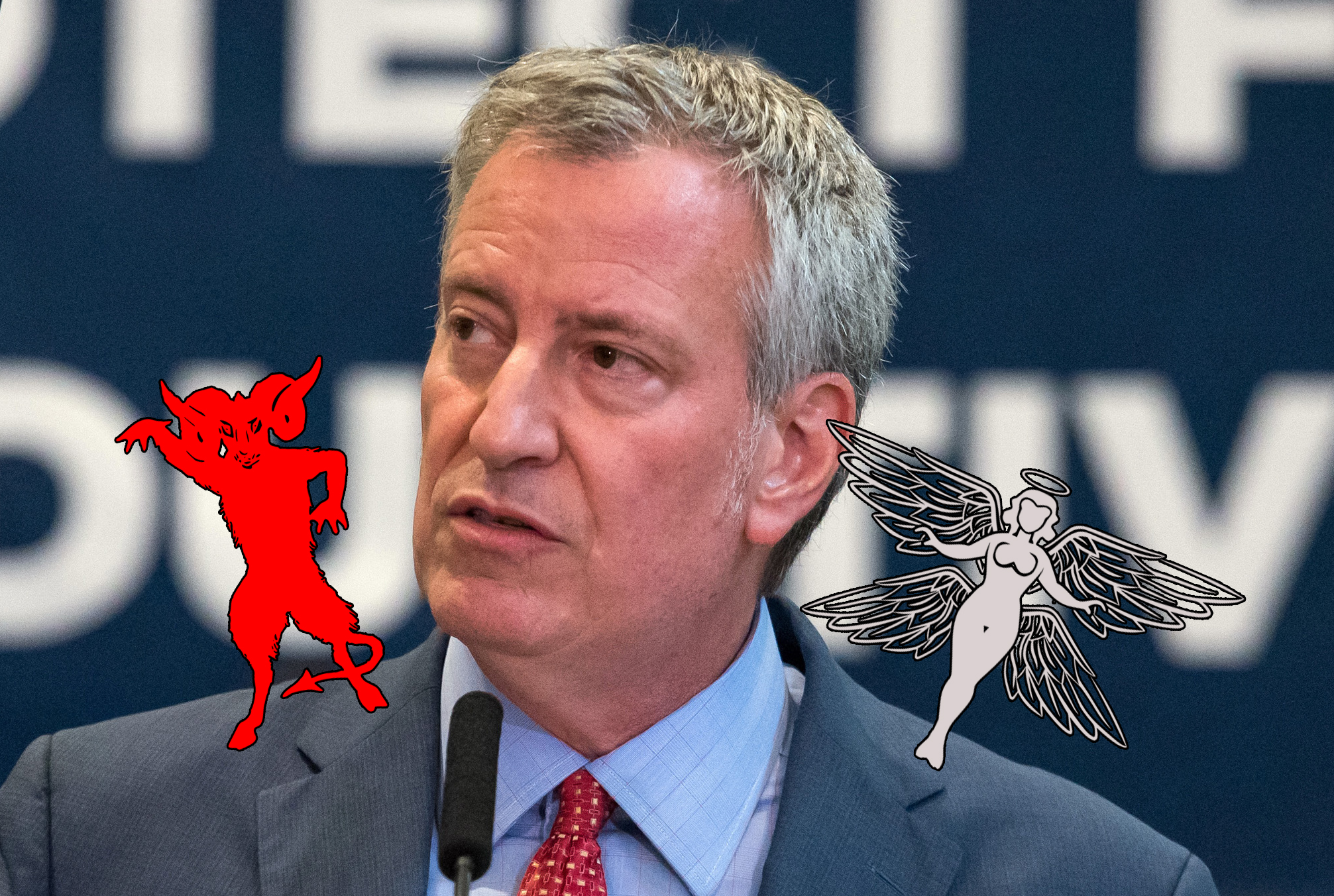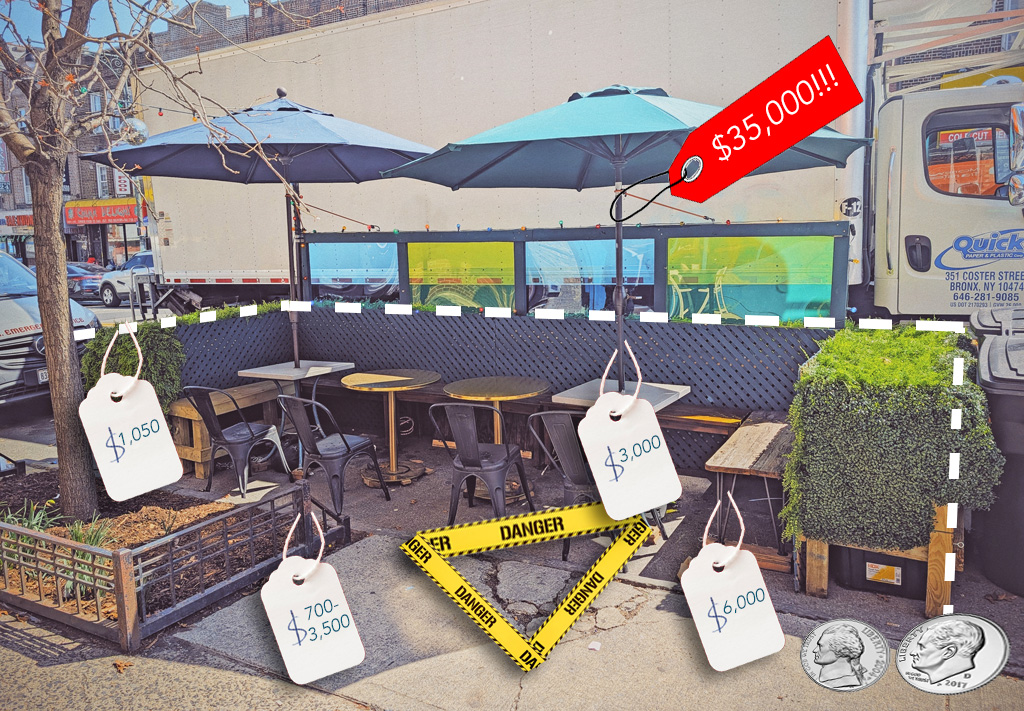No money? No problem!
Mayor de Blasio suggested on Thursday that his administration's commitment to Vision Zero can't be measured by things like "money" that pays for street safety "work," and that instead it should be measured in how much the mayor says he really cares about it.
"By definition we're going to prioritize Vision Zero," the mayor told Streetsblog in response to a question about why he cut $10 million in Vision Zero funding this week, compared to zero dollars in cuts for programs that benefit car drivers.
The mayor's comments on the transportation implication of his cuts were the first since City Hall shared the grim COVID-19 budget adjustments. Those savings slashed $1.3 billion across city agencies and caused pain in many areas, including public safety, education, health and sanitation.
At the Department of Transportation though, Vision Zero projects and the bike network expansion took the biggest combined hits, with $4 million in cuts to spending on street markings and materials spending on Vision Zero Street Improvement Projects, $3 million on spending for Vision Zero public service announcements and another $3 million on building protected bike lanes under the "Green Wave" initiative, which had entered 2020 with so much promise.
In defending those cuts, rather than any road or bridge repair or really anything else in the DOT's billion-dollar budget, the mayor insisted that the proposed savings targeted money that can't be spent at the moment and that they didn't signal any suggested priorities in his administration.
Here was our question and his answer:
Question: We all know that a budget is not just numbers, but it's an agenda, a signifier of priorities. You issued some cuts that were, that slashed Vision Zero programs by about $10 million yet may have no cuts to any Department of Transportation, expense, budget allocations for road building or maintenance. So I'm wondering what that says about your priorities during this crisis and beyond this crisis, that cyclists and pedestrians are sacrificing key programs but drivers are not?
Mayor: No, it does not say that – and I would contest you on your understanding of what's been put out or we'll put out clearer information. A lot of work of the Department of Transportation has to continue because the most basic maintenance like keeping, you know, the classic New York question of keeping our bridges intact and strong, road maintenance, that's about immediate safety issues. All of that has to continue. But there's a lot that isn't continuing as normal. And clearly the Vision Zero work required a certain amount of consistency in the overall work on our streets. If that was being reduced in different ways it was going to affect our ability to do as much Vision Zero work as quickly. So in truth, I think your initial assumption that everything else is the same except the Vision Zero couldn't be farther from the truth.
The Vision Zero work is continuing in many, many ways. As we get back to normal and DOT ramps up more by definition, we're going to prioritize Vision Zero. But what you're seeing a lot in the budget, Gersh, is things that we care deeply about are being held off because normal operations don't exist. I mean, look at professional training in our schools, something that's been the absolute foundation of how we make schools better. We can't do it if teachers are not in their schools. And there's many examples like that. If you look carefully and we'll – our folks will go over it with you – a lot of things in the budget proposal that's been put out so far are about money that just can't be spent because normal operations are not going on. Hopefully that's a very limited period of time and then we can ramp back up. But Vision Zero has always been a priority, always will be a priority.
Cuts to things like professional training in schools, as unfortunate as those are, carry a certain logic. No one is attending city schools, after all, and education facilities are unlikely reopen in this academic year. The DOT still employs its full workforce, and roadwork is still being done, which means that the city could still paint bike lanes or put down some jersey barriers if it really wanted to. The mayor also promised that the successful car-free 14th Street busway pilot would be expanded this year.
The way the mayor is talking, such expansions seem in doubt. Meanwhile, San Francisco's transportation chief Jeffrey Tumlin is using the crisis to talk about reimagining how people get around that city, which Streetsblog SF described as planning for peace when the war against the virus is over (just listen to these two minutes of vision from Tumlin to get the idea).
And, despite the mayor's answer, advocates and budget analysts suggested that budget adjustments do indeed exist to set priorities and send signals.
"This process is supposed to force a commissioner to be very clear and strict in setting priorities," said Maria Doulis, vice president of the Citizens Budget Commission. "You have to be very clear about what is most critical to the mission of your agency and what you're willing to reduce or go without."
Taking money away from these specific areas was very much a choice, which means that it's fair to ask where the DOT's priorities lie, said Jon Orcutt, the former DOT director of policy who is now Bike New York's director of communications.
"We know tax revenue is down and choices have to be made, we just don't understand why all of DOT's choices have to fall in this [Vision Zero] area," said Orcutt. "This is small potatoes in transportation terms. The pedestrianization of Times Square took place in the depths of the Great Recession, so this stuff doesn't cost a lot of money."
As a matter of priorities, Orcutt added, focusing the budget cuts on street safety (and a $7.9-million cut in funding for the Better Buses initiative) winds up putting the city behind in perhaps worse ways than some deferred maintenance. A slowdown this year on bus and safety infrastructure means delays to the vital groundwork necessary to reach the mandate of the Streets Master plan law: 50 miles of bike lanes and 30 miles of bus lanes per year and doubling the amount of pedestrian plazas in the city starting in 2022.
"A road or a bridge doesn't fall apart in an unrecoverable way in a year. What was key to the negotiations on the master plan law is that we'd see more bike lanes this year, next year, and into 2022. And that's just on the bike side," said Orcutt.
In his lengthy answer to Streetsblog, the mayor had promised to explain to critics of the cuts how the budget adjustments will not slow down his administration's progress on street safety, but a mayoral spokesperson called back and merely said that the budget adjustments came out of all the agencies' expense budgets and not the capital budgets — though that is not an explanation why car-related DOT expenses were not cut.
Further questions to DOT asking specifically what aspect of Vision Zero and Green Wave work is being affected by these savings were not answered.






